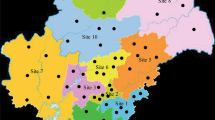Abstract
This paper summarizes a 4-year survey focused on polycyclic aromatic hydrocarbons (PAHs) and halogenated persistent organic pollutants (POPs) in river sediments, soil and crops collected in the locality impacted by catastrophic floods that occurred in the western part of Bohemia in August 2002. In spite of relatively high levels of polychlorinated biphenyls (PCBs) in river sediments, the increase of these POPs in flooded arable soil was not significant. On the other hand, remarkably higher levels of PAHs and dichlorodiphenyl trichloroethane (DDTs) were found as compared to those in reference soil samples. Regardless of this increased soil pollution, no measurable elevated concentrations of POPs occurred in the wheat grown in this area.


Similar content being viewed by others
References
Chiou CT, Sheng G, Manes MA (2001) Partition-limited model for the plant uptake of organic contaminants from soil and water. Environ Sci Technol 35:1437–1444. doi:10.1021/es0017561
Cousins IT, Jones KC (1998) Air–soil exchange of semivolatile organic compounds (SOCs) in the UK. Environ Pollut 102:105–118. doi:10.1016/S0269-7491(98)00069-4
de Wit CA (2002) An overview of brominated flame retardants in the environment. Chemosphere 46:583–624. doi:10.1016/S0045-6535(01)00225-9
Elhottová D, Krištůfek V, Tříska J, Chrastný V, Uhlířová E, Kalčík J, Picek T (2006) Immediate Impact of the flood (Bohemia, august 2002) on selected soil characteristics. Water Air Soil Pollut 173:177–193. doi:10.1007/s11270-005-9054-1
Harrad SJ, Sewart AP, Alcock R, Boumphrey R, Burnett V, Duarte-Davidson R et al (1994) Polychlorinated biphenyls (PCBs) in the British environment: sinks sources and temporal trends. Environ Pollut 85:131–146. doi:10.1016/0269-7491(94)90079-5
Götz R, Bauer O-H, Friesel P, Herrmann T, Jantzen E, Kutzke M et al (2007) Vertical profile of PCDD/Fs, dioxin-like PCBs, other PCBs, PAHs, chlorobenzenes, DDX, HCHs, organotin compounds and chlorinated ethers in dated sediment/soil cores from flood-plains of the river Elbe, Germany. Chemosphere 67:592–603. doi:10.1016/j.chemosphere.2006.09.065
Jánská M, Hajšlová J, Tomaniová M, Kocourek V, Vávrová M (2006) Polycyclic aromatic hydrocarbons in fruits and vegetables grown in the Czech Republic. Bull Environ Contam Toxicol 77:492–499. doi:10.1007/s00128-006-1091-y
McLachlan MS, Welsch-Pausch K, Tolls J (1995) Field validation of a model of the uptake of gaseous SOC in Lolium multiflorum (Welsh Ray Grass). Environ Sci Technol 29:1998–2004. doi:10.1021/es00008a018
Meijer SN, Ockenden WA, Sweetman A, Breivik K, Grimalt JO, Jones KC (2003) Global distribution and budget of PCBs and HCB in background surface soils: implications for sources and environmental processes. Environ Sci Technol 37:667–672. doi:10.1021/es025809l
Nakajima D, Yoshida Y, Suzuki J, Suzuki S (1995) Seasonal changes in the concentration of polycyclic aromatic hydrocarbons in azalea leaves and relationship to atmospheric concentration. Chemosphere 30:409–418. doi:10.1016/0045-6535(94)00420-Y
Stachel B, Christoph EH, Götz R, Herrmann T, Krüger F, Kühn T et al (2006) Contamination of the alluvial plain, feeding-stuffs and foodstuffs with polychlorinated dibenzo-p-dioxins, polychlorinated dibenzofurans (PCDD/Fs), dioxin-like polychlorinated biphenyls (DL-PCBs) and mercury from the River Elbe in the light of the flood event in August 2002. Sci Total Environ 364: 96–112. doi:10.1016/j.scitotenv.2005.07.004
Thomas GO, Sweetman AJ, Ockenden WA, Mackay D, Jones KC (1998) Air-pasture transfer of PCBs. Environ Sci Technol 32:936–942. doi:10.1021/es970761a
Tolls J, McLachlan MS (1994) Partitioning of semivolatile organic compounds between air and Lolium multiflorum (Welsh ray grass). Environ Sci Technol 28:159–166. doi:10.1021/es00050a022
Acknowledgments
This study was supported financially by the Ministry of Education, Youth and Sports of the Czech Republic as a part of a COST Action 629 “Water pollution in natural porous media at different scales: fate, impact and indicator” and MSM 6046137305).
Author information
Authors and Affiliations
Corresponding author
Rights and permissions
About this article
Cite this article
Pulkrabová, J., Suchanová, M., Tomaniová, M. et al. Organic Pollutants in Areas Impacted by Flooding in 2002: A 4-Year Survey. Bull Environ Contam Toxicol 81, 299–304 (2008). https://doi.org/10.1007/s00128-008-9486-6
Received:
Accepted:
Published:
Issue Date:
DOI: https://doi.org/10.1007/s00128-008-9486-6




